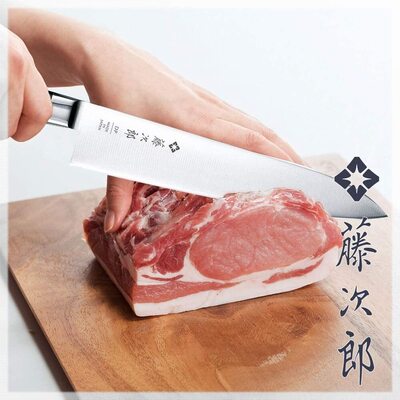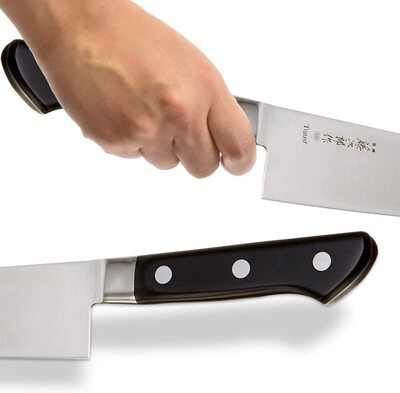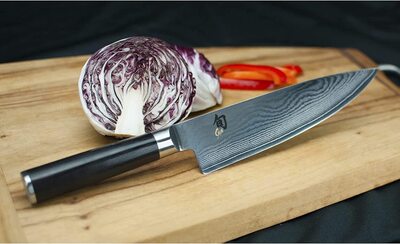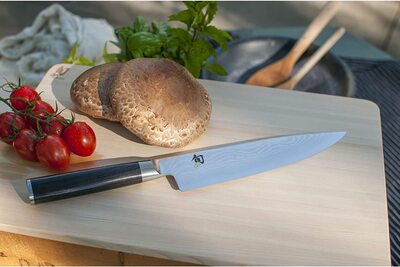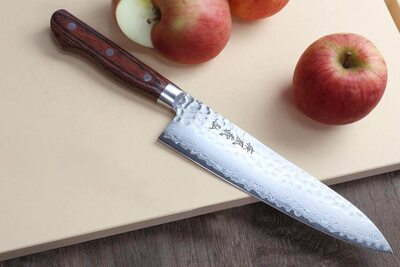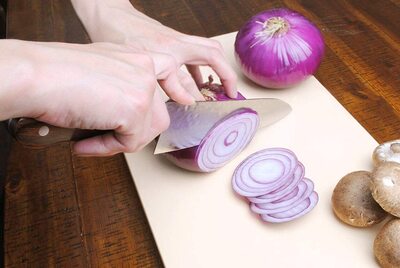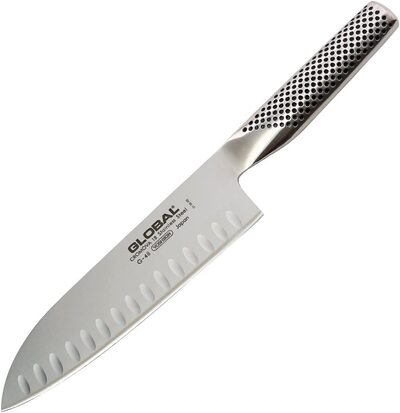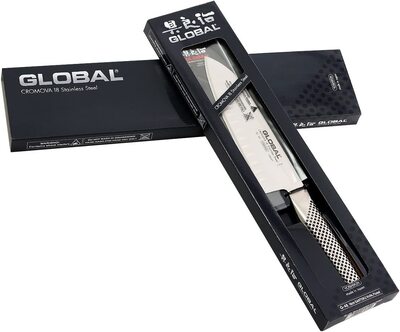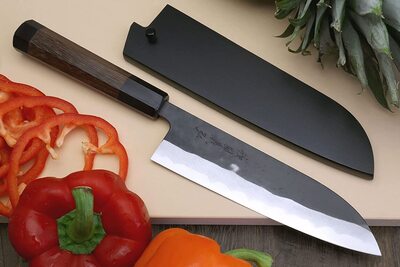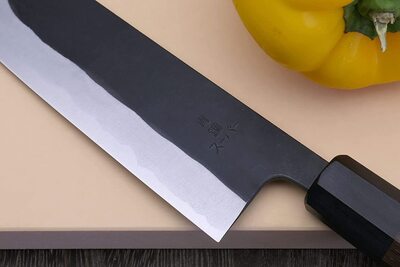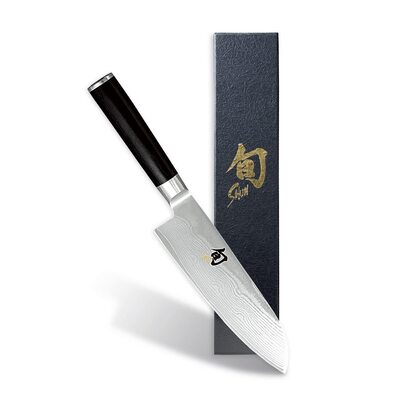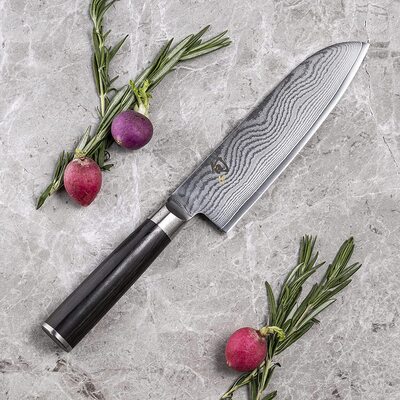Gyuto Vs Santoku [2023] | Similarities & Differences
Gyuto Vs Santoku [2023 | Similarities, Differences and Key Features
Today, we’ll be covering Gyuto vs Santoku knives. If you’re trying to decide which of the two to settle on, don’t fret—our information will make the selection process easier for you.
We’ll briefly explore the differences between these two knives. Without further delay, let’s dive in.
Gyuto Vs Santoku: The War
Suppose you are a home cook or a professional Chef, you are aware that Japanese knives are the finest in the market.
Undeniably, Japan is well-known for making high-quality durable knives. Moreover, their cutlery has been developed for centuries.
Japanese knives are divided into various types, depending on the specific task they can carry out.
These knives deliver exceptional performance and attract a wide variety of consumers worldwide.
Today, we’ll be covering Gyuto vs Santoku knives. If you’re trying to decide which of the two to settle on, don’t fret—our information will make the selection process easier for you.
We’ll briefly explore the differences between these two knives. Without further delay, let’s dive in.
Best Gyuto Knives
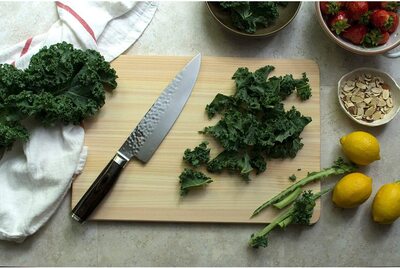
[1] Tojiro DP Gyutou – Budget Friendly
If you’re looking for an affordable Japanese kitchen knife considered to be the best Japanese Gyuto knife, then the Tojiro DP Gyutou is an excellent option to look into.
Furthermore, if you’re a newbie to this whole Japanese knife frenzy, you’ll enjoy using this knife since it’s easy to use.
VG-10 Steel Construction…
This chef knife blade is made from VG10 steel; this implies that it’s incredibly sharp. Also, the VG10 steel is engulfed in 13 chrome stainless steel. Lastly, it’s made from forged steel.
Pakkawood handle…
This knife’s handle is constructed from Pakkawood. The best Japanese knives’ handles are often made from this material, ensuring they last longer.
Pros
- Affordable
- Pakkawood handle
- It’s bevel is double-edged
- Beginner friendly
Cons
- Not efficient while cutting large fruits
[2] Shun Classic 8″ Chef’s Knife – Premium Choice
Are you looking for a superior quality Japanese knife or the best Gyuto knife that will deliver an outstanding performance?
Well, if that’s the case, then you need to look into Shun Classic 8” Chef’s Knife.
Peak performance…
This all-purpose knife is made using the Samurai sword tradition. Furthermore, it follows up to 100 handcrafted steps!
Its blade is constructed from VG10 steel, which is incredibly sharp and highly durable.
Comfortable handle…
This knife’s handle is made from Pakkawood. As we mentioned earlier, knives’ handles made from Pakkawood are long-lasting and have helpful features.
Versatile Knife…
The Shun Classic 8” knife is a diverse knife that’s capable of multitasking. This knife is excellent at cutting vegetables, fish, and poultry.
If you’re on the hunt for a multi-purpose knife, you can settle on this efficient knife.
Pros
- Lifetime warranty
- Very sharp
- Pakkawood handle
- Versatile knife
Cons
- Relatively expensive
[3] Yoshihiro VG10 Gyuto Chef’s Knife – Best Alternative
If you need a versatile knife that delivers peak performance, Yoshihiro VG10 Gyuto Chef’s knife is one of the best Japanese chef knives. It’s a worthy option.
Mahogany handle…
All of the knives we have mentioned are made of Pakkawood except for this knife,
which is constructed from Mahogany.
This knife’s handle can last long once you take care of it.
16-layer Damascus Steel…
This handcrafted knife is crafted from VG 10 steel and then layered with Damascus steel, making it highly durable and incredibly sharp.
Furthermore, since it’s a multi-purpose knife, it’s capable of slicing, dicing, mincing, chopping, and slicing.
This knife is very long-lasting, which explains why they offer a lifetime warranty after purchasing this unit.
Pros
- Durable
- Constructed from Damascus steel
- Long-lasting
- Lightweight
Cons
- The handle is not long-lasting
Best Santoku Knives
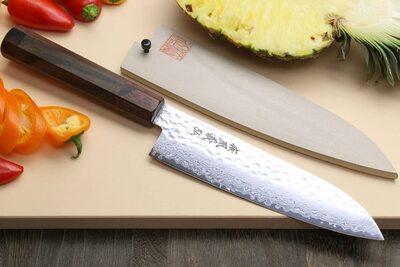
[1] Global G-48-7 inch Santoku Knife – Budget Friendly
The Global G-4-7 inch Knife is a versatile knife that can carry out a variety of tasks.
Santoku means “three virtues.” This implies that these knives are multi-purpose.
Molybdenum/Vanadium blade and handle…
This knife’s blade and handle are crafted from molybdenum/vanadium stainless steel. This steel is rust and stain-resistant.
Moreover, while using this, you need to be very careful because it’s incredibly sharp.
Most high-quality knife handles are made from Mahogany or Pakkawood.
However, this knife’s handle is unique since it’s constructed from molybdenum. Lastly, the grip is dimpled, making sure you are comfortable while holding it.
Pros
- Comfortable handle
- Lightweight
- Rust/stain resistant
- Has a long taper
Cons
- Bad performer in heavy-duty chopping
[2] Yoshihiro Mizu Yaki Aogami Super Blue High Carbon Steel Kurouchi Santoku Knife – Premium Choice
If you’re on the hunt for the best santoku knife, Yoshihiro Mizu Yaki Aogami Super Blue High Carbon Steel Santoku Knife is a worthy choice.
Mizu Yaki is simply a process that involves pure water quenching.
It goes through the Mizu Yaki and Kurouchi process…
You need to know that irrespective of how hard steel is, it also needs to be tough. That way, you’ll be sure that your knife is durable.
The Mizu Yaki process ensures a blade is tough.
On the flip side, Kurouchi means “Black forged”; this is a traditional process of making high carbon knives highly durable and sharp.
Diverse…
As we mentioned earlier, santoku means “three ways or virtues.” Therefore, this is a multi-purpose knife that is efficient in carrying out various tasks.
Its blade is thin and short, making it useful in cutting meat, poultry, fish, vegetables, and fruits.
Pros
- Multi-purpose knife
- It’s lightweight
- Easy to use
Cons
- Relatively pricey
[3]Shun DM0702 Classic 7-Inch Santoku Knife – Best Alternative
This Classic Shun Knife is a handy Santoku knife that’s worth investing in.
Throughout the years, this knife has improved its performance while continuing with the same design.
Pakkawood handle…
Pakkawood handles are moisture-resistant and thus last longer compared to other grips.
Crafted from high-quality materials…
This knife blade is crafted from high-carbon steel, a material well known for making the sharpest knives.
Also, the fact that this knife is sharp ensures it has outstanding knife-edge retention.
Pros
- The blade is crafted from high carbon steel
- Pakkawood handle
- The blade is extra sharp
- Excellent edge retention
Cons
- Relatively pricey
Check Latest Price on Amazon
[lyte id=’https://www.youtube.com/watch?v=6c4RD5E4vcs’ /]
Gyuto vs Santoku: Comparison Table
| Criteria | Gyuto | Santoku |
|---|---|---|
| Sharpening Skills | Intermediate | Intermediate |
| Uses | Chopping, cutting, slicing, dicing, and mincing. A great multi-purpose knife | Chopping, cutting, slicing, dicing, and mincing. A great multi-purpose knife |
| Bevel | Double bevel | There are both double bevel and single bevel santoku knives on the market. |
| Price | Prices range from mid-range to high end. | Costs average at mid-range |
| Weight | A bit on the heavier side | Lightweight |
Gyuto vs Santoku: Features Compare
Since we are comparing two superior quality knives, we’ll need to pitch these knives against each other in deeper aspects such as features, cutting style, and so on.
If you want to know how Gyuto vs Santoku knives’ features compare against each other, stick around for detailed information.
Gyuto
Gyuto translates to “cows sword“. This Japanese style knife was originally made to cut large chunks of meat.
Gyuto knives are very versatile. They will carry out a diversity of tasks efficiently.
A Gyuto knife will effectively carry out chopping, slicing, mincing, and dicing of vegetables, meat, and fish.
These Japanese style chef’s knife tends to be very long. Nonetheless, the average size is 10 to 12 inches.
If you prefer rock cutting techniques during food preparation, then Gyuto is the right choice for you. These Japanese knives can only be double beveled.
Gyuto knives’ handles differ depending on the brand. However, most handles are made from either Pakkawood or Mahogany. Therefore, their handles are exceptionally durable.
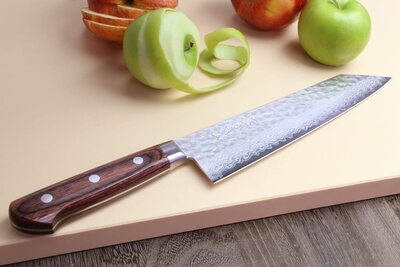
Santoku
The Santoku knife, also known as “Bukabocho“, is an excellent multi-purpose knife. Santoku means “three ways” or “three virtues”.
These knives originated in the 1940s when Japanese artisans tried to give their Nakiri knife western features.
The primary reason why they tried to convert their knives was to make them appropriate for kitchen tasks.
Santoku knives are suitable for different tasks since they are multi-purpose.
These wide sheep’s foot blade shape knives can slice, dice, chop and mince vegetables, meat, and fish.
This knife type has a flat blade that’s no bigger than 7”, which helps to cut efficiently on small cutting boards.
These Japanese knives can be single beveled and double beveled.
Santoku knives’ handles differ depending on the brand constructing them. Nonetheless, the handles are often crafted from superior quality materials.
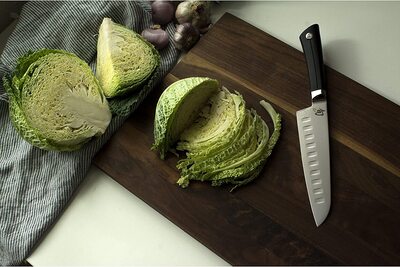
Santoku vs Gyuto Knife: Similarities
Before deciding which of the two knives are appropriate for you, you need to know the similarities.
Below we’ll comprehensively cover the similarities between the santoku vs chef’s knife.
First, these are general-purpose knives. They can carry out a diversity of tasks efficiently.
Both Gyuto and Santoku knives can effectively chop, dice, slice, and mince vegetables, meat, and fish.
Moreover, both of these knives originated in Japan. Also, the brands that offer the best santoku and Gyuto knives are based in Japan.
These knives are constructed using traditional Japanese methods that were passed from generation to generation.
These Japanese blades are constructed from high-quality steel.
It doesn’t matter whether it’s high carbon or stainless steel; the brands that manufacture Gyuto and Santoku knives make sure to use the best steel.
Why steel is best? Read our article “Ceramic vs Steel Knives” to understand the pros and cons of steel.
On to the next point, these knives’ handles are made from superior standard materials such as Pakkawood, Molybdenum, and Mahogany.
This construction allows you to hold the knives comfortably.
Gyuto vs Santoku Knife: Differences
Origin
Gyuto translates to “Cow’s sword”. It was initially made to cut large chunks of meat.
On the other hand, a santoku knife was formerly a Nakiri knife. In 1940, Japanese artisans added Western features, making it efficient for home use.
Shape
Gyuto knives are relatively long compared to Santoku knives. Their average length is 14 inches.
They also have a pointy tip. On the flip side, Santoku knives are often shorter; this makes them safe for home use—their length averages 7 inches.
Gyuto Knife vs Santoku Knife: Key Features
As we compare Santoku vs Gyuto knives, we’ll cover their benefits as well. It’s essential to know these knives’ advantages before purchasing either one of them.
| Gyuto Knife Features |
|---|
| 1. It’s a long length that makes it easier to cut large vegetables such as Cabbages. |
| 2. It has a thin, hard, and sharp blade, thus durable. |
| 3. It has a pointy tip that allows it to penetrate easily between hard surfaces. |
| 4. It has a curved blade design. |
| Santoku Knife Features |
|---|
| 1. It has a shorter blade that makes it efficient for cooks with average skills. |
| 2. Since it has a sharp edge, it’s safe to use. |
| 3. It has a flat blade that enables it to make clean straight cuts. |
| 4. They are relatively affordable. |

Which knife is better: Gyuto or Santoku?
Before purchasing either one of these knives, you need to consider a few factors. That way, you’ll decide which blade is suitable for you.
Does Size Matter?
If you are looking for a knife with a long blade efficient in chopping large vegetables, a Gyuto knife is an excellent choice for you.
Nonetheless, long edges aren’t for everyone. Moreover, they are harder to use, unlike Santoku knives that have a shorter blade.
Most cooks with average skills prefer using Santoku knives. Remember that you’ll use the knife you’ll settle on frequently.
Therefore, it’s best to choose a blade that’s comfortable in your hands.
What is your Budget?
Some people don’t have to consider the amount of money they’re spending.
However, other people have to monitor every single dollar they spend. It’s best to choose a knife that you can afford; also, make sure that it has the features you’re looking for.
What type of knife chopper are you?
If you are a “rock chopper,” then it’s best to settle for a Gyuto knife since it has a curved blade.
On the other hand, if you want a flat edge that’s capable of carrying out multi-purpose tasks, the santoku knife is an impeccable choice for you.
Are you a scraper?
If you’re always in a rush and you need a knife that’s fast to work. We highly advise you to use the Santoku knife.
This knife has a blade that makes it easier to operate. Moreover, it’s safer compared to the Gyuto knife.
If you’re into scraping, you need to know that Gyuto blades can be a little bit messy.
The Common Parts of a Knife
Whether you’re a cook or merely curious, we have detailed information that will come in handy while using a knife.
For some people, they don’t have to know the different parts of a knife.
However, it’s essential knowledge that you’ll use while buying a new blade. Below are other aspects of a knife.
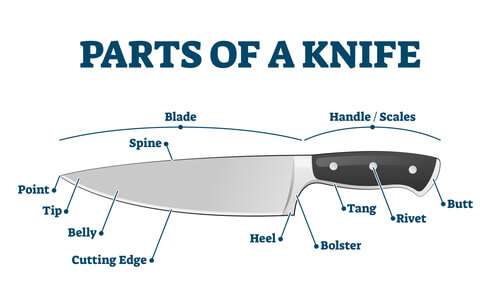
Quick Tips
Both of the knives that we have reviewed are great additions to your kitchen.
But while choosing the knives, you need to focus on the blade—of course, it needs to be sharp enough to carry out your tasks.
You can send your knives to professional knife sharpeners or use whetstone by yourself to keep your knife sharp. Also, you have to think about your safety and comfort.
Final Words
While choosing between Gyuto vs Santoku knives, you have to consider your personal preferences.
That’s the only way you’ll end up with a high-quality knife that will adhere to all your needs.
Also, you have to remember that these knives aren’t suitable for heavy-duty tasks.


